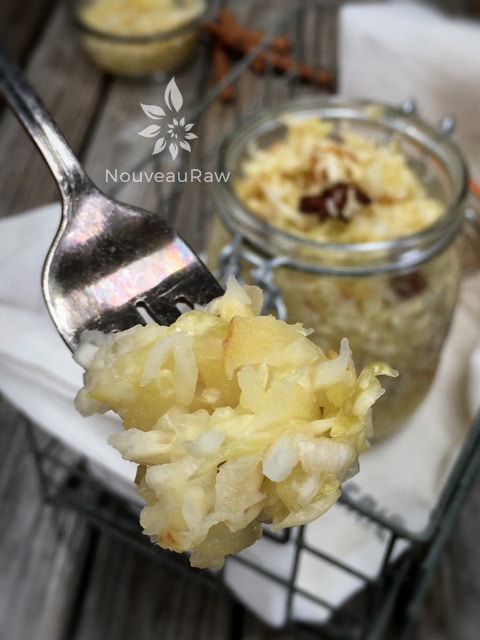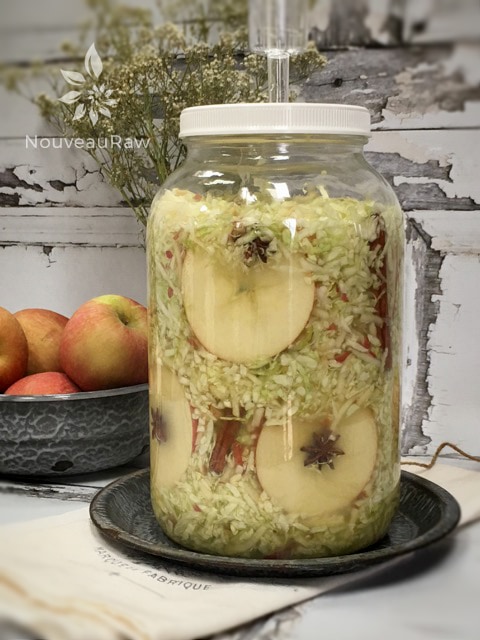


 Add to favorites
Add to favorites
~ raw, vegan, gluten-free, cultured ~
After creating this sauerkraut, I ate some every day, right out of the jar, for over a month. I would find myself standing at the fridge, taking just a bite and putting it back on the shelf.
Update: I originally wrote this post seven months ago. Last week I found a small jar of the same batch in the back of the fridge… I know, I know. Anyway, it still tasted amazing! So, for the sake of science, I ate it all.
Truthfully, I love cultured foods and could have polished it off within just a few days. But, I am trying to not only savor and extend the enjoyment of this recipe, but I am also expressing some gentle love to my digestive system.
You see, I have a delicate system that can be easily thrown off track. And due to the powerful health benefits of cultured foods… I have to ease into them. The gut is home to both good and bad bacteria and if you flood it too soon with too much of the good stuff… you might experience some noticeable side effects.
If you start to notices changes in your body such as diarrhea, constipation, gas, or bloating, your body is telling you to back off for a while or reduce the amount you are consuming, then build back up slowly.
My approach is to have a spoonful before each meal or even before a snack if possible. Fermented foods don’t just lounge around your belly doing nothing, they’re active! Those bacterial armies get to work, helping to balance your gut bacteria and stomach acids. They also release enzymes to help ease and improve digestion.
Fermented, aka cultured foods, are known to help “heal and seal” your gut which will get you on your way towards optimal health. You can’t rely on cultured foods alone… but it can be a beneficial addition to your health care practices.
For this recipe, I decided to try a new product called Cutting Edge. I have made krauts without it, but I am always looking for ways to boost the foods that we eat. According to their packaging, “Cutting edge starter culture is a synergistic blend of carefully selected strains – each plays a vital role in optimizing the natural lacto fermentation process to ensure that you achieve healthy and delicious results. Optimize the natural lacto fermentation process. Supercharge your vegetables, enhance taste and crispness, and ensure that your cultured foods are rich in probiotics. It also helps to create tasty, consistent results and a quicker, more complete fermentation.“
I am always on the quest to learn. Always learning and always teaching… that is why I share all that I do with you. I hope you enjoy this refreshing kraut. Please comment below. Many blessings, amie sue
 Ingredients:
Ingredients:Cutting Edge Starter
Kraut base:
Decoration & flavoring:
 Things to be aware of:
Things to be aware of:White Layer on the Surface:
A white film that is not fuzzy or in round patches is called kahm yeast. It is common when culturing vegetables and quite safe. It can look scary and unpleasant and even smell a little strong, but it is not a harmful thing.
Excess amounts of Kahm can affect the flavor of what you are fermenting. There are many different factors as to what may cause this; insufficiently acidic, not enough salt in the brine, or culturing temperature is too warm.
Keep the fermented veggies submerged:
I made this last week, and it’s amazing! It tastes more like apple pie than sauerkraut, but since I love both those flavors, I absolutely love it. Will be making this again, thanks so much!
Awesome amcgrath815! So happy that you are enjoying the recipe. I love this one too… and I love the fact that you can keep stored in the fridge for months to come. Great raw food staple to have. Thanks so much for sharing. Blessings, amie sue
Hi Amie, please what are coconut crystals?
Good evening Patyreal,
Coconut crystals is similar to brown sugar in looks and taste. It is made from coconut sap. https://nouveauraw.com/recommended-ingredients/sweeteners/coconut-secret-coconut-crystals-raw-12-ounce/
Blessings, amie sue
Thank you!